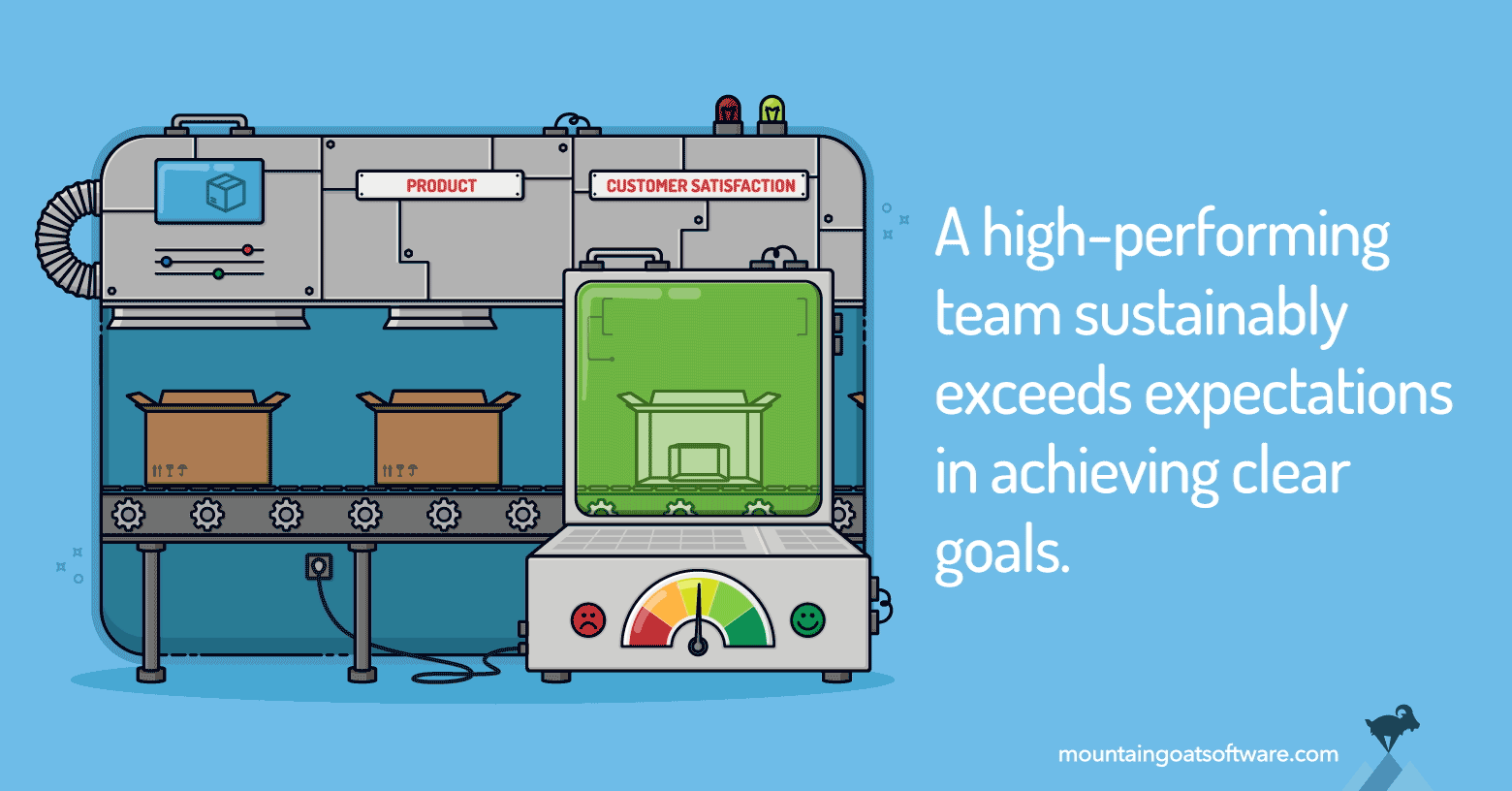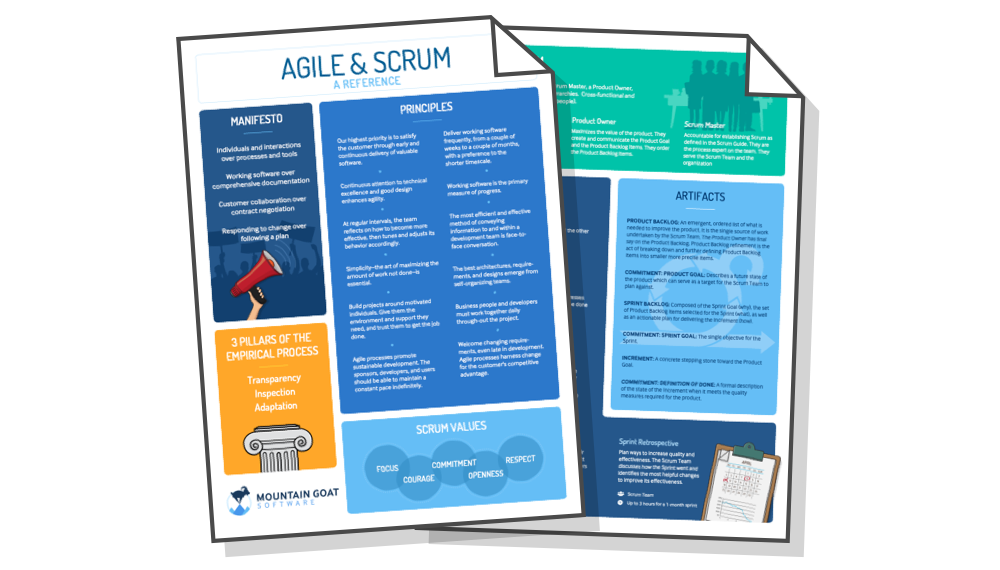I often say that our goal within Mountain Goat is to create high-performing teams. More than anything, I love helping good teams become great teams.
And what is a high-performing team? A high-performing team sustainably exceeds expectations in achieving clear goals.
To do this, team members engage in participative leadership, use minimal process, collaborate well, respect each other and their differences, trust one another, work with urgency and focus, manage conflict in a healthy manner, share a high sense of morale, and succeed or fail as a team.
There’s a lot to those two sentences! So let’s dig deeper: I will explain those components.
What Does a High-Performing Agile Team Look Like?
To discover what makes a good team become great, let’s break down my definition of a high-performing Scrum team: A high-performing team sustainably exceeds expectations in achieving clear goals.
Exceeds Expectations
Let’s start with “exceeds expectations.” To be considered high performing, a team must do better than expected. If you take the top superstars in your company, put them on a team, and they perform just a little bit better than the average team in your company—that doesn’t sound like a high-performing team to me.
To better understand this, suppose you’ve made a movie. You release it to theaters and sell $100 million in tickets. On the surface of it, you’ve made a successful movie. In 2019, the last full year of theatrical movie releases before Covid, only 29 of over 200 movies earned more than $100 million, according to IMDB.
Your movie is proudly among them. The only problem is that your movie stars Dwayne Johnson, Ryan Reynolds, Will Smith, Angelina Jolie, Gal Gadot, Melissa McCarthy, and Viola Davis. Your budget just on stars was well over $100 million. To be considered high performing, your movie must meet higher expectations.
Achieving Clear Goals
A high-performing team will seek clarity in its goals. Team members will embrace the fact that a goal will evolve.
But even as the goal evolves, members of a high-performing team will at all times be moving together toward the same goal.
Sustainably
Anyone can get lucky occasionally. I hit three green lights in a row this morning. Any team might exceed expectations occasionally.
A high-performing team does it again and again, without burnout. Without burnout is important. As stated in the Agile Manifesto: teams “should be able to maintain a constant pace indefinitely.”
High-performing teams sustainably exceed expectations.
How Does a Scrum Team Become High Performing?
To help understand what makes a good team great, let’s examine some common characteristics of high performing teams:
- engage in participative leadership,
- use minimal process,
- collaborate well,
- respect each other and their differences,
- trust one another,
- work with urgency and focus,
- manage conflict in a healthy manner,
- develop and share a high sense of morale, and
- agree that they succeed or fail as a team.
Let’s take a look at each of the things a high-performing team does.
Participative Leadership
High-performing agile development teams rarely have autocratic leaders who make decisions without input from the team. Instead, high-performing teams engage in participative leadership: team members collaborate to make decisions.
Within an agile team structure, participative leadership can span a spectrum from developers fully empowered to make decisions to the sort of team that provides recommendations to a leader—such as a Scrum Master or product owner—who ultimately makes decisions.
At a minimum, team members are encouraged to contribute to the decision-making process.
Minimal Process
No matter how novel a team’s product or project may be, some elements of its development occur repeatedly. High-performing teams develop just enough process to streamline and facilitate those elements of their work.
Their teamwork process can be viewed like the lines on a highway. The lines are there to help vehicles travel more quickly. The process helps agile teams work quickly. When more process than necessary has been added, members of a high-performing team remove the unneeded elements.
Collaborate Well
In general, teams exist to do something that couldn’t be done by one person alone (or something that’s done faster when by a team). Communication overhead and mistakes will always exist on a project with more than one person. That’s why the scrum framework, and other agile ways of working, recommend small cross-functional teams, with complementary skill sets.
The best teams communicate well and often. Scrum makes frequent communication easy with daily scrum meetings. Members of high-performing teams are also adept at using the right medium for each communication, sometimes emailing, Slacking, calling, or meeting face-to-face either in person or through video.
Respect Each Other and Their Differences
For optimal performance, a team moves quickly. Some teams will use the need for speed to justify what can only be called a lack of respect. For example, rather than mindfully inviting dissenting views, such a team may rush to a decision after hearing only a couple of opinions. This is disrespectful to those whose opinions dissented or were not even heard.
By contrast, members of a high-performing team respect one another and value their differences. Members of these teams will have often fierce, but always respectful, debates before choosing among alternatives.
Trust
Members of a high-performing team know and trust one another. This may just seem like a simple nice-to-have. But for shortening time-to-value, it’s critical .
To see why, suppose you and I are on the same team. Your work cannot begin until my work is well underway. Perhaps I’m designing something you’ll code. On a high-performing team, you trust that I will deliver my partial implementation on the date promised and that it will be as far along as we’d agreed upon.
Without trust, you’d spend time checking up on me. Perhaps it’s just an email. But even that is something. And I would have to respond to those requests. This slows both of us down, increasing the time-to-value of that product or feature.
Work with Urgency and Focus
High-performing teams rise to meet challenges. Without a challenge, a team is unlikely to rise to high performance.
Eliud Kipchoge is the current world record holder for the marathon, having run it 2:01:39. I suspect he occasionally goes for a Sunday run in the park, just for fun. When he does, he’s running a whole lot faster than I ever will or have but nowhere near his best.
Teams perform best with slightly aggressive but realistic deadlines. That increases the urgency and requires more focus so team members avoid distractions.
The best teams strive to meet urgent goals because they believe in the value of their product. They know people will benefit from the new functionality and they are excited to deliver it as early as possible.
Manage Conflict
Great teams manage conflict. That does not mean they avoid conflict. Some conflict is necessary and arguing about a solution is often the only way to ensure the best solution is chosen.
High-performing teams will form guidelines, whether formal or informal, to prevent conflicts from escalating or persisting. It’s fine to disagree and to argue. But on a high-performing team, the conflict and disagreement needs to be forgotten once a direction forward has been selected.
A High Sense of Morale
High-performing teams are characterized by a high sense of morale. There is a feeling of invincibility and that no challenge is too great. (High-performing teams also know their limits and do know to speak up when something cannot be done.)
The confidence of a high-performing team is contagious. Other development teams will see it and want it for themselves. And people who have experienced a high-performing team working towards a common goal will seek to experience it again on any future teams they join.
Succeed as a Team
It is impossible to become a high-performing team without team members feeling they succeed or fail together. They are all successful or they have all failed. No one on a high-performing team would ever dare say, “We failed, but I succeeded.”
This means that to the extent possible, members of a high-performing team help one another out. If I’m behind on something, you’ll help me out. And if you’re behind and I can possibly help, I will.
This goes beyond doing the work of a sprint or iteration; it extends even into agile practices such as planning. If I am about to overcommit myself for the coming sprint, my colleagues on a high-performing team should step in and stop me, or at least warn me. Together, we get the work to done.
Why High Performance Matters
Organizations will always strive to do more with less. So there will also be an organizational desire for high-performing teams.
I value them, however, for a different reason: They’re simply more fun to be part of.
Think about working as part of a team every day that has all the qualities I just described. You’re exceeding expectations time and again while working toward a shared, clear goal.
You and all your teammates participate in making decisions. You have some process in place, but just enough to help you move quickly. You’re collaborating well. You trust and respect each other so that conflict becomes a creative rather than destructive influence. You believe in what you’re making, which lends urgent focus and high morale. And with your teammates each helping one another, you know you will succeed as a team. That sounds like fun to me.
What Do You Think?
What do you think? Is yours a high-performing team? Or have you been on one in the past? What do you think is missing or unnecessary in my list above?
Please share your thoughts in the Comments section below.









